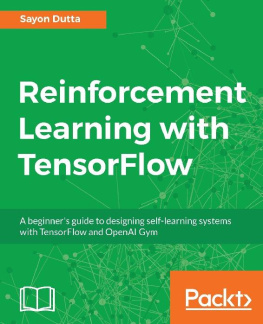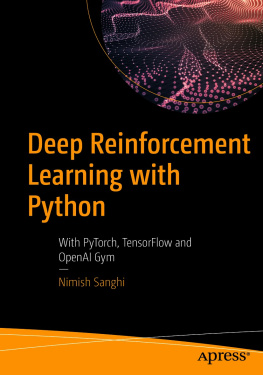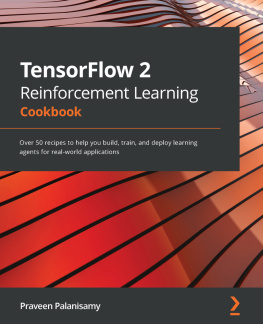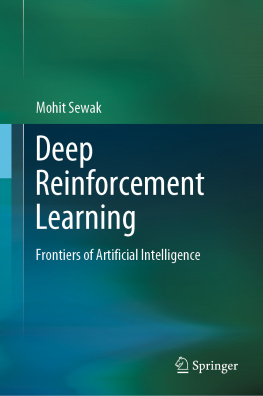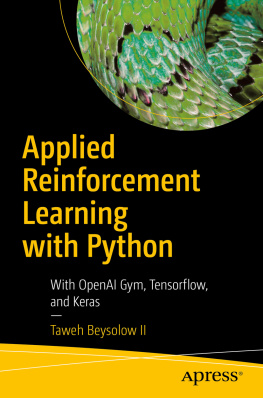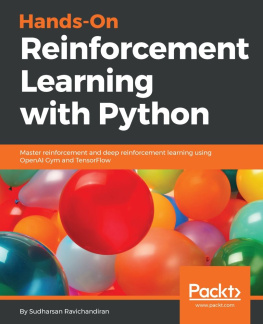Sayon Dutta - Reinforcement Learning With TensorFlow: A Beginner’s Guide to Designing Self-Learning Systems With TensorFlow and OpenAI Gym
Here you can read online Sayon Dutta - Reinforcement Learning With TensorFlow: A Beginner’s Guide to Designing Self-Learning Systems With TensorFlow and OpenAI Gym full text of the book (entire story) in english for free. Download pdf and epub, get meaning, cover and reviews about this ebook. year: 2018, publisher: Packt Publishing, genre: Computer. Description of the work, (preface) as well as reviews are available. Best literature library LitArk.com created for fans of good reading and offers a wide selection of genres:
Romance novel
Science fiction
Adventure
Detective
Science
History
Home and family
Prose
Art
Politics
Computer
Non-fiction
Religion
Business
Children
Humor
Choose a favorite category and find really read worthwhile books. Enjoy immersion in the world of imagination, feel the emotions of the characters or learn something new for yourself, make an fascinating discovery.
- Book:Reinforcement Learning With TensorFlow: A Beginner’s Guide to Designing Self-Learning Systems With TensorFlow and OpenAI Gym
- Author:
- Publisher:Packt Publishing
- Genre:
- Year:2018
- Rating:3 / 5
- Favourites:Add to favourites
- Your mark:
Reinforcement Learning With TensorFlow: A Beginner’s Guide to Designing Self-Learning Systems With TensorFlow and OpenAI Gym: summary, description and annotation
We offer to read an annotation, description, summary or preface (depends on what the author of the book "Reinforcement Learning With TensorFlow: A Beginner’s Guide to Designing Self-Learning Systems With TensorFlow and OpenAI Gym" wrote himself). If you haven't found the necessary information about the book — write in the comments, we will try to find it.
Leverage the power of reinforcement learning techniques to develop self-learning systems using TensorFlow
Key Features- Explore reinforcement learning concepts and their implementation using TensorFlow
- Discover different problem-solving methods for reinforcement learning
- Apply reinforcement learning to autonomous driving cars, robobrokers, and more
Reinforcement learning (RL) allows you to develop smart, quick and self-learning systems in your business surroundings. Its an effective method for training learning agents and solving a variety of problems in Artificial Intelligence - from games, self-driving cars and robots, to enterprise applications such as data center energy saving (cooling data centers) and smart warehousing solutions.
The book covers major advancements and successes achieved in deep reinforcement learning by synergizing deep neural network architectures with reinforcement learning. Youll also be introduced to the concept of reinforcement learning, its advantages and the reasons why its gaining so much popularity. Youll explore MDPs, Monte Carlo tree searches, dynamic programming such as policy and value iteration, and temporal difference learning such as Q-learning and SARSA. You will use TensorFlow and OpenAI Gym to build simple neural network models that learn from their own actions. You will also see how reinforcement learning algorithms play a role in games, image processing and NLP.
By the end of this book, you will have gained a firm understanding of what reinforcement learning is and understand how to put your knowledge to practical use by leveraging the power of TensorFlow and OpenAI Gym.
What you will learn- Implement state-of-the-art reinforcement learning algorithms from the basics
- Discover various reinforcement learning techniques such as MDP, Q Learning, and more
- Explore the applications of reinforcement learning in advertisement, image processing, and NLP
- Teach a reinforcement learning model to play a game using TensorFlow and OpenAI Gym
- Understand how reinforcement learning applications are used in robotics
If you want to get started with reinforcement learning using TensorFlow in the most practical way, this book will be a useful resource. The book assumes prior knowledge of machine learning and neural network programming concepts, as well as some understanding of the TensorFlow framework. No previous experience of reinforcement learning is required.
Table of Contents- Deep Learning - Architectures and Frameworks
- Training Reinforcement Learning Agents Using OpenAI Gym
- Markov Decision Process (MDP)
- Policy Gradients
- Q-Learning & Deep Q Networks
- Asynchronous Methods
- Robo Everything - Real Strategy Gaming
- AlphaGo - Reinforcement Learning at its Best
- Reinforcement Learning in Autonomous Driving
- Financial Portfolio Management
- Reinforcement Learning in Robotics
- Deep Reinforcement Learning in AdTech
- Reinforcement Learning in Image Processing
- Deep Reinforcement Learning in NLP
- Appendix 1.Further Topics in Reinforcement Learning
**
Sayon Dutta: author's other books
Who wrote Reinforcement Learning With TensorFlow: A Beginner’s Guide to Designing Self-Learning Systems With TensorFlow and OpenAI Gym? Find out the surname, the name of the author of the book and a list of all author's works by series.

